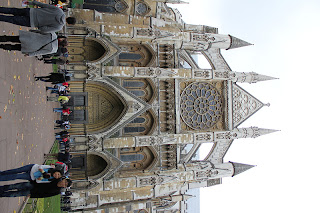So, to save you the embarrassment when you visit a tea shop in England, I'll fill you in. Cream Tea refers to a whole pot of tea served with scones and pastries. It'd be something that you would order if you were going to sit down and chat with your grandmother for several hours- not something you'd order "to go".
The quaint little tea shop in Hastings
Hot tea with cream : )
Once the clock hit 10, we walked across the street to the entrance of "Battle Abbey." Battle Abbey was built on the Battlefield of Hastings.
The Battle of Hastings was a major event in Western history. Before the death of the English king Edward the Confessor (who also happens to be a Roman Catholic Saint buried at Westminster Abbey in London), Edward had promised the throne of England to his cousin William of Normandy. However, on his deathbed, Edward changed his mind and decided to give it to a member of the most powerful family in England, Harold Godwinson. Harold was crowned king and William took this as a declaration of war--he planned to invade England and take the crown he believed was rightfully his.
William and his Normans (decendants of the Vikings who had settled in northern France) crossed the English Channel with a fleet of 700 ships and invaded England in 1066. There has never been another successful invasion of England since.
William made his way north and met Harold and the English army on a plain near the town of Hastings. Nine hours of deadly combat followed. As the English began to sieze the upper hand, an Norman arrow struck King Harold in the eye and he died soon after. The English forces soon began to collapse and William "the Conquer" took the field.
William then made his way to London where he was crowned on Christmas Day, 1066 as King William I of England. This cornation is the first recorded English coronation to take place in Westminster Abbey where subsequent English coronations have taken place up until the present day.
Later, in 1070, Pope Alexander II ordered the Normans to do penance for killing so many people during their conquest of England. So William the Conqueror vowed to build an abbey where the Battle of Hastings had taken place, with the high altar of its church on the supposed spot where King Harold fell in that battle.
Other than being the last successful invasion of England, this battle also marked the beginning of a major change in the English culture and language. The invading Normans were French-speakers and their language began to mix with the very Germanic language of the English. This is why many words in the English language have French roots, such as: servant, acquaintance, and companion.
Visiting this historic abbey and the battlefield was very interesting.
The medieval gate house to "Battle Abbey"
Sarah and Peter standing where the English Army lined up on the Battlefield of Hastings
After exploring Hastings, we settled back into our warm car. Though Peter was doing much better, we didn't want to over-do it, and a little drive allowed him to rest a bit.
Soon, we arrived at Stonehenge! What a cool experience! Stonehenge is surrounded by farm fields, sheep, and tourists. The highlight of the day (possibly even the trip) for Peter were the fluffy white sheep grazing near Stonehenge.
Baaa!
After another two hours in the car, we arrived at Stratford-Upon-Avon at dusk. Stratford-upon-Avon was the birthplace of William Shakespeare and the present day site of his tomb. Unfortunately, Holy Trinity Church where Shakespeare is buried was closed to visitors an hour before we arrived. However, Dan got some pictures of the beautiful church and its surroundings at dusk.
We had planned to spend more time exploring this famous town, but we ended up just snapping some photos and settling into our hotel for an early bedtime for Peter.
The next morning we drove to London and flew back to our home in Turkey...it had been a whirlwind trip, but it was definitely nice to go to a place where EVERYONE spoke English! :)























